

- Phone
- Email puppypetite@aol.com
-
Address
8002 17th Ave, Brooklyn NY 11214
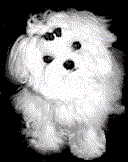
How to House Train a Yorkie Puppy
House training a dog is the process of teaching a pet dog to eliminate outdoors or in a designated area indoors. It is an essential aspect of pet ownership, ensuring that the dog understands where it is acceptable to use as its bathroom. This practice is important not only for maintaining a clean and hygienic living environment but also for ensuring the dog's comfort and well-being.
To successfully house train a dog, pet owners should be hands on and involved: consistency, patience, and positive reinforcement are key. The process includes establishing a routine, supervising the dog, and rewarding the dog when it eliminates in the correct area. It's crucial to understand that house training takes time, and there may be accidents along the way. However, with persistence and the correct approach, any dog can be fully house trained effectively.
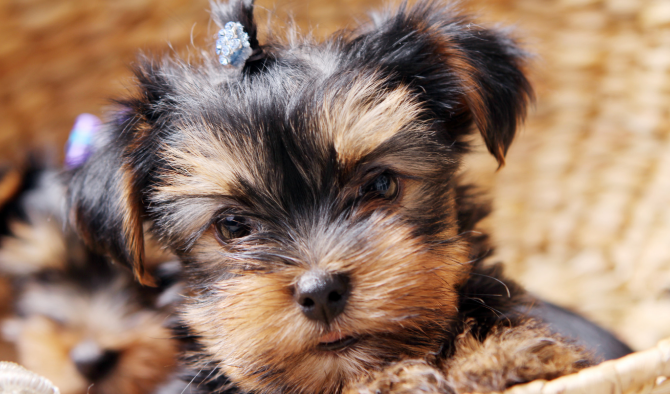

Introducing Yorkie Puppies
A Yorkshire Terrier, commonly known as Yorkie, are a small-sized breed, but they are well-known for their big personalities. Here are some of their most important characteristics pet owners need to know.
Size and Appearance
Yorkies are a toy breed and typically weigh no more than seven pounds. They have a compact, well-proportioned body structure with a small head, medium-sized eyes, and V-shaped ears. Their most striking feature is their coat, which is long, silky, and comes in a steel blue and tan color combination.
Temperament
Yorkies are known for their bold and confident demeanor. They are highly intelligent, active, and overprotective, which can sometimes make them a little aggressive. Despite their small size, they are incredibly brave and often unaware of their size, which can lead to confrontations with larger dogs.
Trainability
Yorkshire Terriers are quick learners. However, their stubborn and independent nature can sometimes make dog training a challenge. Early socialization and consistent, positive reinforcement-based training methods work best with this breed.
Health
Yorkies are generally healthy but can be prone to certain breed-specific health issues, like dental problems, eye infections, and certain knee, liver, and blood disorders. Regular vet check-ups, a balanced diet, and adequate exercise can help maintain their overall well-being.
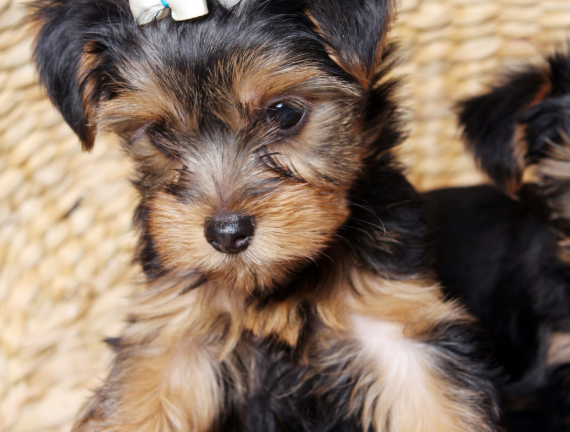
Lifespan
Yorkshire Terriers have a longer life expectancy compared to many other breeds, typically living between 12 to 15 years, and some even longer with good care.
Exercise Needs
Despite their small size, a Yorkshire Terrier is quite active and require regular exercise to keep them physically fit and mentally stimulated. Daily walks, along with playtime and puzzle toys, can help meet their exercise needs.
Grooming
Yorkies require a significant amount of grooming due to their long, silky coat. Regular brushing is necessary to prevent matting and tangling. Many owners opt to keep their Yorkies in a "puppy cut" to reduce the maintenance.
Understanding these characteristics can help potential Yorkshire Terrier owners determine if this breed is the right fit for their lifestyle and provide the best care possible.
Size Considerations for House Training
When it comes to house training, the size of the dog does play a role in the dog training process. For smaller dog breed like Yorkies, their bladder size is significantly smaller compared to larger dogs, meaning they will need to eliminate more frequently. This requires owners to take them outside more often, especially during the initial stages of house training. Owners should be prepared for more frequent outings and possibly more accidents during this time. On the positive side, smaller breeds can be easier to manage indoors and are less likely to cause significant damage if accidents occur.
For larger breeds, their bladder size allows them to hold urine for longer periods, so owners may not need to take them outside as frequently. However, larger dogs can also cause more damage during accidents and may require more rigorous house training methods due to their size. It is important to adjust the training approach depending on the size and needs of the individual dog.
In conclusion, house training is an essential aspect of pet ownership that requires patience, consistency, and positive reinforcement. Understanding a dog's personality and individual needs can help in setting realistic expectations and determining the best approach for successful training. With time and dedication, any dog can be successfully house trained, regardless of its size or breed.
Supplies Needed For House Training A Yorkie Puppy
Crate: A crate serves multiple purposes in crate training a Yorkshire Terrier pup. It provides a safe and comfortable space for the puppy when you're not able to supervise them. Since dogs naturally avoid soiling their sleeping area, it encourages them to hold it until they are taken outside. Choose a crate that is just large enough for the puppy to stand, turn around, and lie down. This way their crate training is not a series of uncomfortable steps for your yorkie.
Puppy Pads: These are useful, especially in the early stages of dog training. They can be placed inside the home in a designated potty area or bathroom area. As Yorkies are small dogs, they may need to relieve themselves more frequently than their larger counterparts.
Leash: A leash is necessary for taking your Yorkie outside for bathroom breaks. It helps you guide your puppy to the right spot and keeps them secure in outdoor spaces.
Treats: Treats are essential for positive reinforcement training. Whenever your Yorkie eliminates in the correct spot, reward them with a treat to reinforce this behavior.
Cleaning Supplies: Accidents are bound to happen during house training. Have pet-friendly cleaning supplies on hand to clean up any messes. Enzyme-based cleaners are a good choice as they can eliminate the odor and discourage the puppy from returning to the same spot.
Baby Gates: These are useful for limiting your Yorkie puppy's access to certain parts of the house during the training process. They can help prevent accidents and keep your puppy in a controlled area where you can keep an eye on them.
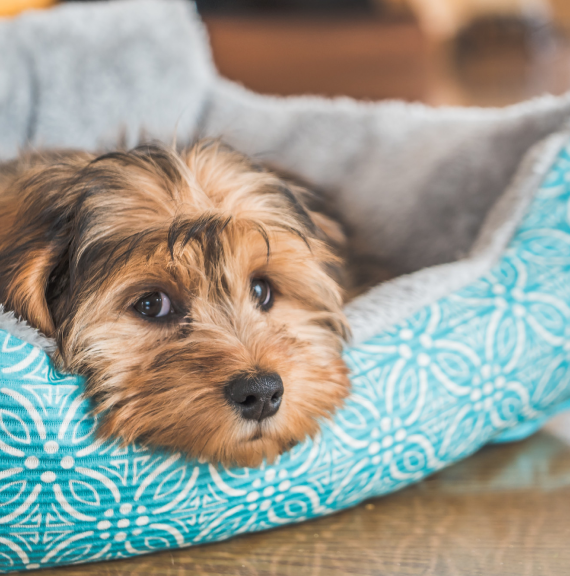
Potty Training Your Yorkie Puppy
Potty training Yorkies requires patience, consistency, and a clear plan. Start by designating an appropriate outdoor area for your puppy to use as its bathroom. Ensure it is easily accessible and relatively quiet to avoid distractions.
Establish a Routine
Yorkies thrive on consistency and routine. Designate specific times for meals, play, and potty breaks and stick to them. Typically, puppies need to eliminate after eating, playing, or waking up from a nap.
Supervision and Guidance
In potty training yorkies, supervise your Yorkie closely, especially in the initial stages of training. Use a leash to guide them to the designated outdoor area each time it's time for a potty break. This helps them understand where they are supposed to go.
Use of Command Words
When taking your puppy to the designated potty spot, use a simple command word like "Go Potty". Over time, this command will help your puppy understand what is expected of them.
Praise and Reward
After your puppy successfully eliminates in the correct spot, immediately reward them with praise and a treat. This reinforces the positive behavior and encourages them to repeat it.
Dealing with Accidents
If your puppy has an accident in the house, it's important to clean the spot thoroughly with an enzyme-based cleaner to remove the smell and discourage them from repeating the behavior. Never punish or scold your puppy for accidents as it will only create fear and confusion.
Potty training is a process that takes time and patience. If progress is slow, don't despair. Consistency and positive reinforcement will eventually lead to success.
Steps in Potty Training Your Yorkie Puppy
The optimal time to start potty training your Yorkie puppy is around 12-16 weeks of age, when they've gained control over their bladder and bowel muscles. However, it's crucial to remember that every puppy is unique, and ready to start at different times. If your puppy is older than 12 weeks when you bring them home, start training immediately. Regardless of age, the key to successfully potty train a yorkie lies in consistency, patience, and positive reinforcement. Remember, it's a learning process, and there will be occasional accidents along the way.
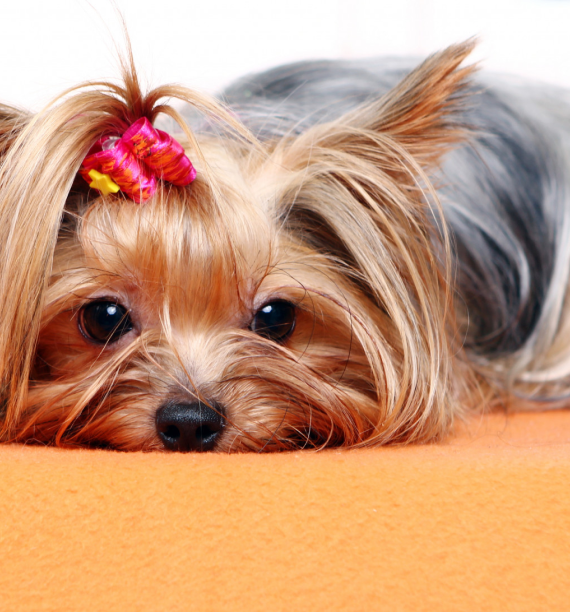
Understanding Your Puppy's Needs
Monitor your Yorkie pup closely to understand their elimination patterns. Usually, puppies need to go after eating, waking up, and extensive play. By understanding their patterns, you can prevent accidents and maintain a consistent routine.
Frequent Potty Breaks
Schedule frequent potty breaks based on your puppy's age and activity levels. This will help the whole process of potty training. A puppy can typically hold their bladder one hour for each month of their age, plus one. So, a three-month-old puppy should ideally be taken out every four hours.
Consistent Spot
Always take your Yorkie puppy to the same spot for elimination. The scent will help remind them why they're there.
Reward System
When your puppy successfully eliminates outside, shower them with praise and give them a treat. This positive reinforcement will encourage them to repeat the behavior.
Accident Handling
If an accident happens, don't scold or punish your puppy. Clean the area thoroughly to remove any scent that might attract them back to the spot. Instead, reinforce the correct behavior by taking them outdoors more frequently and easing them into a fun outdoor training.
Common Challenges and Solutions In House Training
Frequent Accidents
One common challenge faced during house training is frequent accidents. This is especially true for smaller breeds like Yorkies that have smaller bladders and need to eliminate more often. Shorten the gap of your dog's potty break interval, particularly after meals, playtime, and naps. Consistency is key.
Inconsistent Routine
Dogs thrive on routine, and inconsistency can confuse them, leading to accidents. Establish and stick to a consistent routine for feeding and bathroom breaks. This helps your dog understand when it's time to eliminate.
Failing to Signal When Needing to Go Out
Sometimes, a puppy may not know how to signal their need to go out, leading to accidents. Training your dog to use a bell or some other signal can help. Reward them when they signal effectively to go outside, reinforcing this behavior.
Distractions While Outside
Sometimes, puppies get distracted while outside and forget to eliminate, only to have an accident once they're back inside. Designate a specific area as their "bathroom" and bring them straight there during bathroom breaks. Keep outings business-like and reward them for successful elimination.
Fear of the Crate
Some puppies may be uncomfortable in a crate, making it challenging to use it as a house training tool. Make the crate a positive place. Never use it for punishment. You can use treats, toys, and comfy bedding in the crate to make it an enticing space.
Setting realistic expectations is crucial in the process of house training or potty-training dog breeds. Owners should know that puppies and younger dogs typically need more time to learn and adapt to the set routines. Accidents are a normal part of the training process and should not be met with harsh punishment. Instead, continue positive reinforcement for the correct behavior. Even adult dogs, if they have not been previously house trained, may take several weeks to several months to fully grasp the concept. Remember, patience is essential, and every dog learns at its own pace. Thus, understanding your dog's individual needs and learning speed is fundamental in setting achievable goals for house training.
